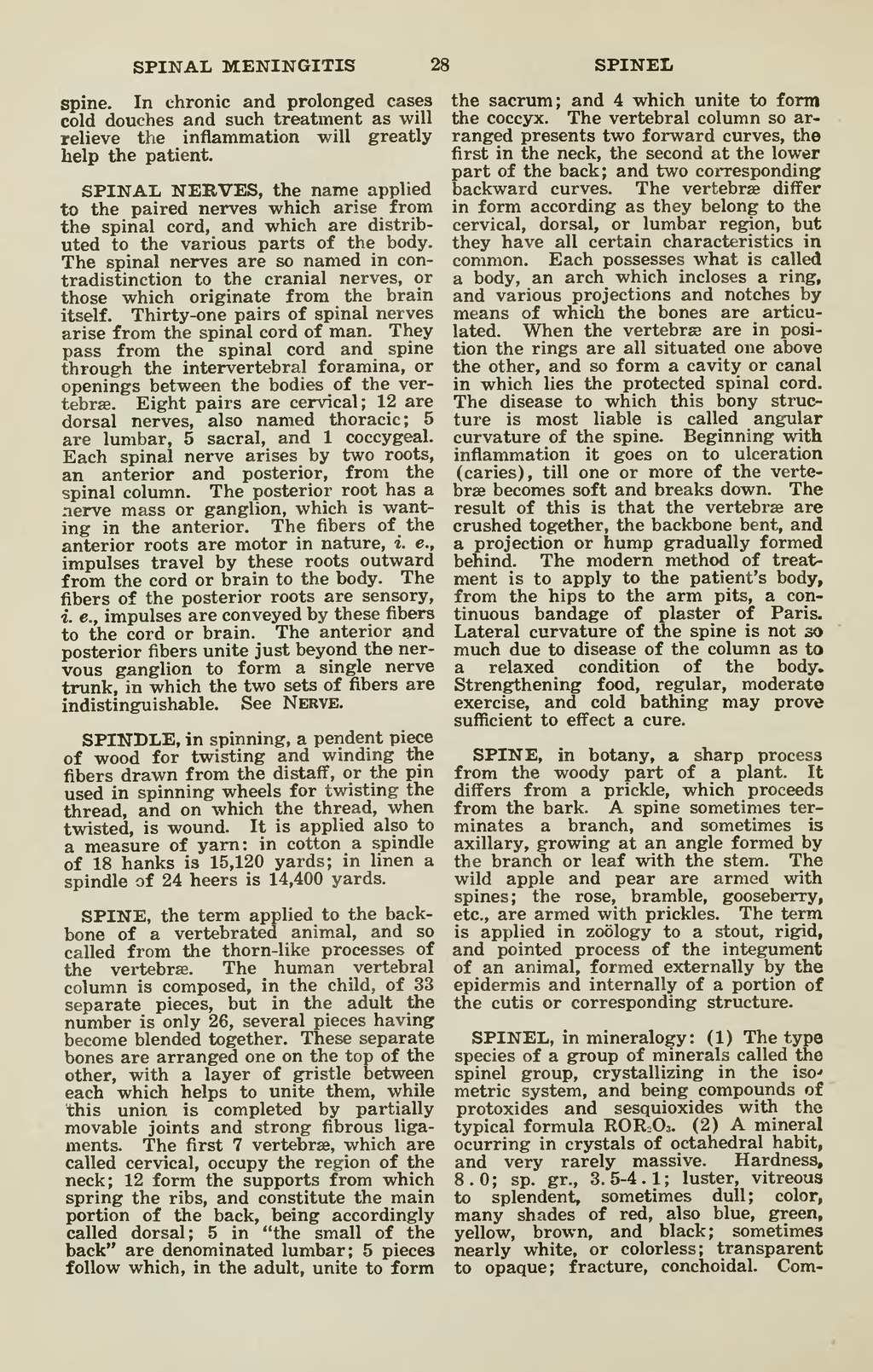SPINAL MENINGITIS 28 spine. In chronic and prolonged cases cold douches and such treatment as will relieve the inflammation will greatly help the patient. SPINAL NERVES, the name applied to the paired nerves which arise from the spinal cord, and which are distrib- uted to the various parts of the body. The spinal nerves are so named in con- tradistinction to the cranial nerves, or those which originate from the brain itself. Thirty-one pairs of spinal nerves arise from the spinal cord of man. They pass from the spinal cord and spine through the intervertebral foramina, or openings between the bodies of the ver- tebras. Eight pairs are cervical; 12 are dorsal nerves, also named thoracic; 5 are lumbar, 5 sacral, and 1 coccygeal. Each spinal nerve arises by two roots, an anterior and posterior, from the spinal column. The posterior root has a nerve mass or ganglion, which is want- ing in the anterior. The fibers of the anterior roots are motor in nature, i. e., impulses travel by these roots outward from the cord or brain to the body. The fibers of the posterior roots are sensory, i. e., impulses are conveyed by these fibers to the cord or brain. The anterior and posterior fibers unite just beyond the ner- vous ganglion to form a single nerve trunk, in which the two sets of fibers are indistinguishable. See Nerve. SPINDLE, in spinning, a pendent piece of wood for twisting and winding the fibers drawn from the distaff, or the pin used in spinning wheels for twisting the thread, and on which the thread, when twisted, is wound. It is applied also to a measure of yarn: in cotton a spindle of 18 hanks is 15,120 yards; in linen a spindle of 24 heers is 14,400 yards. SPINE, the term applied to the back- bone of a vertebrated animal, and so called from the thorn-like processes of the vertebrae. The human vertebral column is composed, in the child, of 33 separate pieces, but in the adult the number is only 26, several pieces having become blended together. These separate bones are arranged one on the top of the other, with a layer of gristle between each which helps to unite them, while this union is completed by partially movable joints and strong fibrous liga- ments. The first 7 vertebras, which are called cervical, occupy the region of the neck; 12 form the supports from which spring the ribs, and constitute the main portion of the back, being accordingly called dorsal; 5 in "the small of the back" are denominated lumbar; 5 pieces follow which, in the adult, unite to form SPINEL the sacrum; and 4 which unite to form the coccyx. The vertebral column so ar- ranged presents two fonvard curves, the first in the neck, the second at the lower part of the back; and two corresponding backward curves. The vertebrae differ in form according as they belong to the cervical, dorsal, or lumbar region, but they have all certain characteristics in common. Each possesses what is called a body, an arch which incloses a ring, and various projections and notches by means of which the bones are articu- lated. When the vertebras are in posi- tion the rings are all situated one above the other, and so form a cavity or canal in which lies the protected spinal cord. The disease to which this bony struc- ture is most liable is called angular curvature of the spine. Beginning with inflammation it goes on to ulceration (caries), till one or more of the verte- brae becomes soft and breaks down. The result of this is that the vertebrae are crushed together, the backbone bent, and a projection or hump gradually formed behind. The modern method of treat- ment is to apply to the patient's body, from the hips to the arm pits, a con- tinuous bandage of plaster of Paris. Lateral curvature of the spine is not so much due to disease of the column as to a relaxed condition of the body. Strengthening food, regular, moderate exercise, and cold bathing may prove sufficient to effect a cure. SPINE, in botany, a sharp process from the woody part of a plant. It differs from a prickle, which proceeds from the bark. A spine sometimes ter- minates a branch, and sometimes is axillary, growing at an angle formed by the branch or leaf with the stem. The wild apple and pear are armed with spines; the rose, bramble, gooseberry, etc., are armed with prickles. The term is applied in zoology to a stout, rigid, and pointed process of the integument of an animal, formed externally by the epidermis and internally of a portion of the cutis or corresponding structure. SPINEL, in mineralogy: (1) The type species of a group of minerals called the spinel group, crystallizing in the iso-* metric system, and being compounds of protoxides and sesquioxides with the typical formula ROR.Os. (2) A mineral ocurring in crystals of octahedral habit, and very rarely massive. Hardness, 8.0; sp. gr., 3.5-4.1; luster, vitreous to splendent, sometimes dull; color, many shades of red, also blue, green, yellow, brown, and black; sometimes nearly white, or colorless; transparent to opaque; fracture, conchoidal. Com-
Page:Collier's New Encyclopedia v. 09.djvu/54
This page needs to be proofread.
LEFT
28
RIGHT
